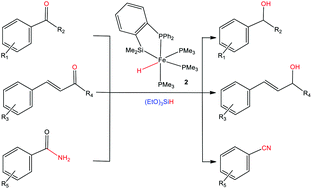当前位置:
X-MOL 学术
›
Dalton Trans.
›
论文详情
Our official English website, www.x-mol.net, welcomes your
feedback! (Note: you will need to create a separate account there.)
Synthesis of silyl iron hydride via Si–H activation and its dual catalytic application in the hydrosilylation of carbonyl compounds and dehydration of benzamides†
Dalton Transactions ( IF 3.5 ) Pub Date : 2018-02-17 00:00:00 , DOI: 10.1039/c8dt00289d Shishuai Ren 1, 2, 3, 4, 5 , Shangqing Xie 1, 2, 3, 4, 5 , Tingting Zheng 1, 2, 3, 4, 5 , Yangyang Wang 1, 2, 3, 4, 5 , Shilu Xu 1, 2, 3, 4, 5 , Benjing Xue 1, 2, 3, 4, 5 , Xiaoyan Li 1, 2, 3, 4, 5 , Hongjian Sun 1, 2, 3, 4, 5 , Olaf Fuhr 6, 7, 8, 9 , Dieter Fenske 6, 7, 8, 9
Dalton Transactions ( IF 3.5 ) Pub Date : 2018-02-17 00:00:00 , DOI: 10.1039/c8dt00289d Shishuai Ren 1, 2, 3, 4, 5 , Shangqing Xie 1, 2, 3, 4, 5 , Tingting Zheng 1, 2, 3, 4, 5 , Yangyang Wang 1, 2, 3, 4, 5 , Shilu Xu 1, 2, 3, 4, 5 , Benjing Xue 1, 2, 3, 4, 5 , Xiaoyan Li 1, 2, 3, 4, 5 , Hongjian Sun 1, 2, 3, 4, 5 , Olaf Fuhr 6, 7, 8, 9 , Dieter Fenske 6, 7, 8, 9
Affiliation

|
The hydrido silyl iron complex (o-Ph2PC6H4SiMe2)Fe(PMe3)3H (2) was obtained via the activation of the Si–H bond of the bidentate silyl ligand o-Ph2P(C6H4)SiMe2H (1) by Fe(PMe3)4. 2 showed good to excellent catalytic activity in both the reduction of aldehydes/ketones and the dehydration of benzamide. In addition, with complex 2 as a catalyst, α,β-unsaturated carbonyls could be selectively reduced to the corresponding α,β-unsaturated alcohols. The mechanisms of the formation of 2 and the catalytic dehydration process are proposed and partly experimentally verified.
中文翻译:

通过Si–H活化 合成氢化甲硅烷基铁及其在羰基化合物的氢化硅烷化和苯甲酰胺脱水中的双重催化作用†
氢化硅烷基铁络合物(o -Ph 2 PC 6 H 4 SiMe 2)Fe(PMe 3)3 H(2)是通过激活双齿甲硅烷基配体o -Ph 2 P(C)的Si–H键而获得的Fe(PMe 3)4形成6 H 4)SiMe 2 H(1)。图2在醛/酮的还原和苯甲酰胺的脱水中均显示出良好至优异的催化活性。另外,带复数2作为催化剂,α,β-不饱和羰基可以选择性地还原为相应的α,β-不饱和醇。提出了2的形成机理和催化脱水过程,并进行了部分实验验证。
更新日期:2018-02-17
中文翻译:

通过Si–H活化 合成氢化甲硅烷基铁及其在羰基化合物的氢化硅烷化和苯甲酰胺脱水中的双重催化作用†
氢化硅烷基铁络合物(o -Ph 2 PC 6 H 4 SiMe 2)Fe(PMe 3)3 H(2)是通过激活双齿甲硅烷基配体o -Ph 2 P(C)的Si–H键而获得的Fe(PMe 3)4形成6 H 4)SiMe 2 H(1)。图2在醛/酮的还原和苯甲酰胺的脱水中均显示出良好至优异的催化活性。另外,带复数2作为催化剂,α,β-不饱和羰基可以选择性地还原为相应的α,β-不饱和醇。提出了2的形成机理和催化脱水过程,并进行了部分实验验证。











































 京公网安备 11010802027423号
京公网安备 11010802027423号